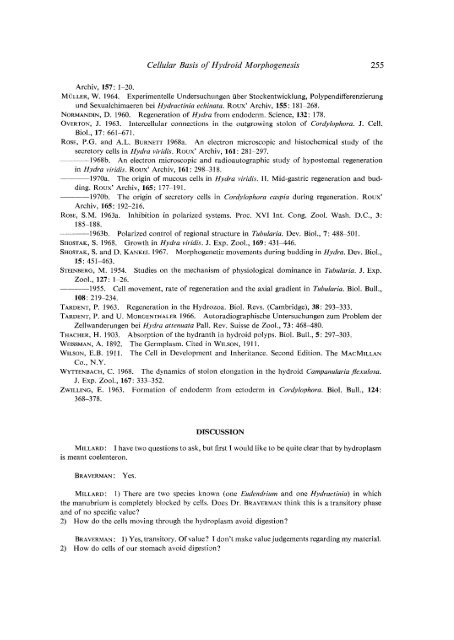THE CELLULAR BASIS OF HYDROID MORPHOGENESIS
THE CELLULAR BASIS OF HYDROID MORPHOGENESIS
THE CELLULAR BASIS OF HYDROID MORPHOGENESIS
Create successful ePaper yourself
Turn your PDF publications into a flip-book with our unique Google optimized e-Paper software.
Cellular Basis of Hydroid Morphogenesis 255<br />
Archiv, 157: 1-20.<br />
MuLLER, W. 1964. Experimentelle Undersuchungen iiher Stockentwicklung, Polypendifferenzierung<br />
und Sexualchimaeren bei Hydractinia echinata. Roux' Archiv, 155: 181-268.<br />
NoRMANDIN, D. 1960. Regeneration of Hydra from endoderm. Science, 132: 178.<br />
OVERTON, J. 1963. Intercellular connections in the outgrowing stolon of Cordylophora. J. Cell.<br />
Bioi., 17: 661-671.<br />
RosE, P.G. and A.L. BuRNETT 1968a. An electron microscopic and histochemical study of the<br />
secretory cells in Hydra viridis. Roux' Archiv, 161: 281-297.<br />
-~~-1968b. An electron microscopic and radioautographic study of hypostomal regeneration<br />
in Hydra viridis. Roux' Archiv, 161: 298-318.<br />
----1970a. The origin of mucous cells in Hydra viridis. IT. Mid-gastric regeneration and budding.<br />
Roux' Archiv, 165: 177-191.<br />
----1970b. The origin of secretory cells in Cordylophora caspia during regeneration. Roux'<br />
Archiv, 165: 192-216.<br />
RosE, S.M. 1963a. Inhibition in polarized systems. Proc. XVI Int. Cong. Zoo!. Wash. D.C., 3:<br />
185-188.<br />
----1963b. Polarized control of regional structure in Tubularia. Dev. Bioi., 7: 488-501.<br />
SHOSTAK, S. 1968. Growth in Hydra viridis. J. Exp. Zoo!., 169: 431-446.<br />
SHOSTAK, S. and D. KANKEL 1967. Morphogenetic movements during budding in Hydra. Dev. Bioi.,<br />
15: 451-463.<br />
STEINBERG, M. 1954. Studies on the mechanism of physiological dominance in Tubularia. J. Exp.<br />
Zoo!., 127: 1-26.<br />
----1955. Cell movement, rate of regeneration and the axial gradient in Tubu!aria. Bioi. Bull.,<br />
108: 219-234.<br />
TARDENT, P. 1963. Regeneration in the Hydrozoa. Bioi. Revs. (Cambridge), 38: 293-333.<br />
TARDENT, P. and U. MoRGENTHALER 1966. Autoradiographische Untersuchungen zum Problem der<br />
Zellwanderungen bei Hydra attenuata Pall. Rev. Suisse de Zoo!., 73: 468-480.<br />
THACHER, H. 1903. Absorption of the hydranth in hydroid polyps. Bioi. Bull., 5: 297-303.<br />
WEISSMAN, A. 1892. The Germp1asm. Cited in WILSON, 1911.<br />
WILSON, E.B. 1911. The Cell in Development and Inheritance. Second Edition. The MACMILLAN<br />
Co., N.Y.<br />
WYTTENBACH, C. 1968. The dynamics of stolon elongation in the hydroid Campanularia fiexulosa.<br />
J. Exp. Zoo!., 167: 333-352.<br />
ZwiLLING, E. 1963. Formation of endoderm from ectoderm in Cordylophora. Bioi. Bull., 124:<br />
368-378.<br />
DISCUSSION<br />
MILLARD: I have two questions to ask, but first I would like to be quite clear that by hydroplasm<br />
is meant coelenteron.<br />
BRA YERMAN;<br />
Yes.<br />
MILLARD: I) There are two species known (one Eudendrium and one Hydractinia) in which<br />
the manubrium is completely blocked by cells. Does Dr. BRA YERMAN think this is a transitory phase<br />
and of no specific value?<br />
2) How do the cells moving through the hydroplasm avoid digestion?<br />
BRAVERMAN: I) Yes, transitory. Of value? I don't make value judgements regarding my material.<br />
2) How do cells of our stomach avoid digestion?

















